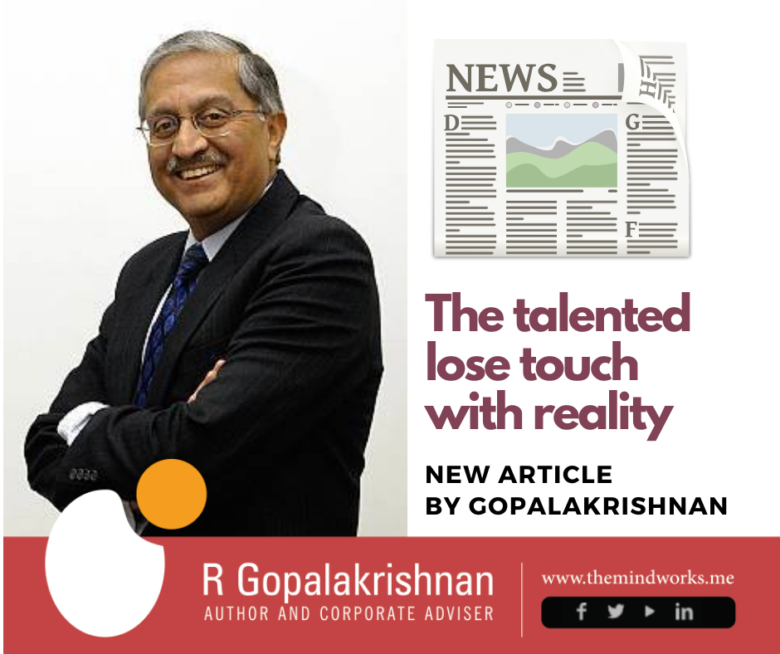10th Nov 2017, BUSINESS STANDARD
R. Gopalakrishnan, Author, Corporate Advisor and Distinguished Professor at IIT Kharagpur
Email : rgopal@themindworks.me
Every species has a natural growth rate, determined by its genetics, metabolism and its environment. Nature frowns on a species grown artificially except within certain limits. Fruit-flies don’t try to become as big as cows, and cows don’t try to become big like elephants. Max Kleiber, a Swiss-born academic at Davis, California, demonstrated in the 1930s that every species has, on an average, a stable number of heartbeats. For example, the cow species is 1000 times heavier than the woodchuck specie. Cows would have a lifespan which is the “square root of the square root of 1000”, which is 5.5 times longer than a woodchuck species. Thefruit fly lives only 15 days compared to the the heavy tortoise–itsimply consumes its quota of heartbeats faster. Could this logic applies to species of companies, which do behave, after all, like living beings? Steel companies are different from FMCG and I.T. companies. Management teaching does not recognize the biological nature of companies; it treats companies as inanimate entities, arguably to a fault.
The Silicon Valley model of start-up technology companies requiresextra-ordinary growth. The model itself isyoung and is not universally applicable. Technology start-ups are a new species, whose biology is not fully understood in respect of, for example, their metabolism, their heartbeats and their longevity. Business management leaders understand the biology of more traditional companies. Whether the Silicon Valley model is suited for Indian entrepreneurship is a much-debated subject.
The foreign funding for Indian technology start-ups fluctuates wildly, from $8 billion in 2015, down to $4 billion in 2016, and up again to $10 billion in 2017. Three important points worth noting: first, this number is small compared to what flowed into Chinese start-ups; second, the flow is influenced as much by markets in USA as by the excitement of the Indian start-ups per se; third, VCs are concentrating their investments into fewer companies–Flipkart alone accounted for 40% of the $10 billion inflow in 2017. At the stroke of a valuer’s pen, Flipkart value was diminished by a few billion dollars just a few days ago.
The Silicon Valley model certainly seems to work in the west and east coasts of USA, as also in China. The briefing by The Economist (23rd Sep) demonstrates how China has surged ahead as a genuine and true technology innovator, besting American entrepreneurs at their own game. Simon Mundy (FT, 25th Oct) observed, “As with so much in India, the development of India’s digital economy will be hard to predict, and resistant to convenient models plucked from elsewhere.”
Common sense suggests that former founders would make better investors as VCs. CB Insights (23rd Oct) crunched the data and found, surprise surprise, that non-founder VCs dominate the top ranks among VCs; further, that there is no relationship between the rank of top VCs and their experience as a founder. This is another evidence to doubt the depth of our collective understanding of the biology of start-up companies.
There are alternative andhugely successful models. The case of D-Mart, started in 2002, is a good example of building an $8 billion enterprise in what might be considered a staid, 1970s service industry of retailing. Radhakishan Damani does not attend Corporate Awards juries or advisory councils of the Finance Minister. As his CEO is reported to have said, “Lofty ideas don’t work in retail. Wins come from small incremental improvements pursued relentlessly.”
The statistics of Patanjali Ayurved as stated in the media are impressive, and suggest the creation of another highly valuable company. Very little of published financial figures are easily available and appear suspect since the media always quotes round numbers for revenue and margin. The sceptics feel that there may be considerable bluster in the business profile that is being written about.Notwithstanding these views, the marketing chutzpah of bringing ayurvedic and natural products into central consciousnessof consumers must accrue to this unusual company with unusual credentials.
In summary, different pulse rates for different start-ups.

